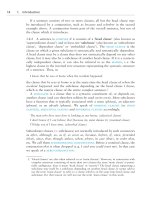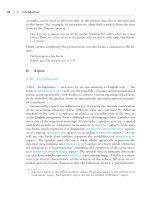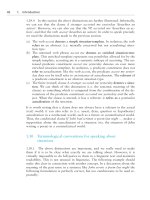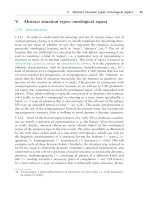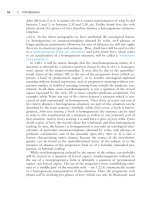The grammar of the english verb phrase part 10 pptx
Bạn đang xem bản rút gọn của tài liệu. Xem và tải ngay bản đầy đủ của tài liệu tại đây (68.05 KB, 7 trang )
56 1. Introduction
John did from 2 to 4, it cannot also be a correct representation of what he did
between 2 and 3, or between 2.30 and 3.30, etc. Unlike drank beer, the verb
phrase drank five glasses of beer therefore denotes a heterogeneous situation-
template.
1.36.4 In the above paragraphs we have attributed the ontological feature
[( homogeneous] to situation-templates denoted by verbs, verb phrases or
longer predicate constituents. However, for ease of reference we will also apply
the term to situation types and sentences. Thus, drink beer will be said to refer
toa‘
homogeneous (type of) situation’ and John drank beer, which refers
to an actualization of a homogeneous situation, will be called a ‘
homogen-
eous sentence
’.
In 1.48.1 it will be noted, though, that the (non)homogeneous nature of a
situation as denoted by a sentence need not always be due to the [( homogen-
eous] nature of the situation-template. It may also be due to the quantifica-
tional status of the subject NP, to the use of the progressive form (which ex-
presses a kind of ‘grammatical aspect’), or to another ontological-aspectual
meaning without formal expression, such as progressive meaning without pro-
gressive marker or habitual meaning coming from outside the predicate con-
stituent. In all these cases (non)homogeneity is not a question of the lexical
aspect expressed by the verb, VP or more complex predicate constituent. For
example, while Water ran out of the cistern denotes a situation which is con-
ceived of (and represented) as homogeneous, Three litres of water ran out of
the cistern denotes a heterogeneous situation: no part of this situation can be
described by the same sentence. Similarly, while John wrote a book is hetero-
geneous, John was writing a book is homogeneous: the sentence can be used
to refer to (the actualization of) a situation as well as to any (relevant) part of
that situation. And in Every evening, I would have a glass of port while Sylvia
drank a glass of beer, the second clause has a habitual, and thus homogeneous
reading. In sum, the feature [( homogeneous] is not only an ontological char-
acteristic of particular situation-templates (denoted by verbs, verb phrases or
predicate constituents) and of the situation types they refer to. It is also a
feature characterizing entire clauses, because the source of the (non)homo-
geneity can be found in the quantificational status of the subject or in the
presence or absence of the progressive form or of a formally unmarked pro-
gressive or habitual reading.
While (non)homogeneity induced by the nature of the subject can probably
still be treated as a question of lexical aspect, (non)homogeneity induced by
the use of a (non)progressive form is definitely a question of ‘grammatical
aspect’, not lexical aspect. The use of the progressive form (establishing refer-
ence to a ‘middle part’ of the situation only Ϫ see 1.22.4) automatically results
in a homogeneous representation of the situation. Thus, the progressive verb
phrase will be drinking five glasses of beer (which can only be felicitously used
V. Abstract situation types: ontological aspect 57
if the number of glasses is determined before the situation starts) represents
the situation referred to as homogeneous: if will be drinking five glasses of
beer can be used to refer to a whole situation, it can also refer to parts of that
situation. However, in this case [( homogeneous] is not an ontological feature
because the choice between a progressive and a nonprogressive form is not a
choice between different lexical items. This has as a consequence that in section
1.42, where we define various ‘situation types’ on the basis of different ontolog-
ical (lexical) features, we will not consider drink and be drinking as denoting
templates for different situation types: in both cases the situation type is an
‘action’, i. e. a dynamic situation which is not a change of state and whose
actualization is caused by a consciously acting agent.
1.37 Ontological feature 4: ‘durative’ vs ‘punctual’
1.37.1 Situations are conceived of as having a certain duration (ϭ durative)
or as needing no more than a moment to actualize (ϭ
punctual, nondura-
tive, momentary
):
They’re printing my book. (durative situation)
I knocked at the door. (punctual situation)
1.37.2 A durative kind of situation normally requires the use of a durative
situation verb phrase
,
19
while a punctual kind of situation always requires
the use of a
punctual situation verb phrase. However, there does not appear
to be a perfect correlation between punctual situation verb phrases and punc-
tual actualizations of situations. There are two problematic areas. To begin
with, on the level of actualization, duration may be the result of repetition.
This renders it possible for a punctual situation verb to be used in a clause
that is interpreted as referring to a durative actualizing situation:
Someone was knocking at the door. (repeated knocks)
The monkey jumped up and down for several minutes. (repeated jumps)
Exactly 14 people stabbed the victim. (punctual on a simultaneous reading Ϫ the
14 people stabbed the victim at the same time Ϫ but durative on the consecutive
interpretation)
So far the serial killer has murdered six prostitutes. (durative on the normal, i. e.
consecutive, interpretation)
19. The word normally is necessary here because, as noted immediately below, duration
may result from repetition, and the idea of repetition can be due to the plurality of the
subject, as in A lot of people entered the church. In this case the sentence denoting a
durative situation does not contain a durative situation VP.
58 1. Introduction
For ease of reference we will include the situations represented in such senten-
ces in the class of durative situations. (When a more precise label is required,
we will speak of a ‘durative hypersituation consisting of (consecutive) punctual
subsituations’.)
Since the idea of ‘durative hypersituation consisting of punctual subsitu-
ations’ can only be triggered by the progressive form or by a constituent of the
sentence which is not the verb itself, it does not play a part in the definition
of durative ontological aspect as denoted by a verb denoting a simple situation-
template. Thus, in the following sentences, all of which refer to situations that
are durative because they are repetitive, the verb used is a ‘punctual situation
verb’:
I shot five soldiers in less than a minute. (The idea of repetition is induced by the
combination of the plural object NP and the durational adverbial Ϫ compare: *I
shot a soldier in less than a minute. In order for the adverbial to make sense, a series
is required to make the situation durative.)
One after the other, the ramblers reached the top of the hill. (The idea of repetition
is induced by the plurality of the subject NP and the duration-implying phrase one
after the other.)
Someone was frantically knocking on the back door. (Repetition is signalled by the
use of the progressive form.)
The above sentences refer to situations which are durative hypersituations con-
sisting of a series of punctual subsituations. Of course, there is no durative
hypersituation if there are a number of punctual situations which all actualize
at the same time, as in one interpretation of The fifty people present nodded.
This sentence refers to (the actualization of) a durative hypersituation if the
fifty people present nodded one after the other. On the interpretation that the
fifty people present nodded at the same time, there is no durative hypersitua-
tion, only one punctual situation involving a multiple-referent subject (similar
to the situation referred to in We reached the top at 5.37, which is treated as
a single punctual situation).
1.37.3 The second reason why there is not a perfect correlation between
punctual situation-templates (denoted by verbs, verb phrases or more complex
predicates) and punctual actualizations of situations is that (as noted in section
1.38.1) verbs like die or kill can be used to refer either to a punctual transition
or to the durative preparatory phase leading up to the transition in question:
He died versus He was dying.
He died instantly versus He died slowly.
She killed him versus She was killing him or She killed him slowly.
Since the durative reading arises only in a suitable context (e. g. in the presence
of a durational adverb) or when the progressive form is used, it does not seem
V. Abstract situation types: ontological aspect 59
to be warranted to classify die, kill, etc. as possibly belonging to the class of
durative situation verbs. We will therefore include these
transitional situa-
tion verbs
into the class of punctual situation verbs but distinguish between a
(punctual)
transition reading and a (durative) preparatory phase reading.
1.37.4 Verb phrases denoting a punctual type of situation cannot co-occur
with a duration adverbial, except if repetition is implied or if a duration adver-
bial can be used to expresses the duration of the resultant state (i. e. the state
resulting from the performance of the action).
*Jill reached the church for three hours. (This is unacceptable because, in the world
as we know it, Jill’s reaching the church is a single punctual actualizing situation,
which could not last for three hours.)
The clown jumped up and down for several minutes. (repeated jumps)
Mother has just left for two hours. (Acceptable only on the reading that her absence
[i. e. the resultant state] will last for two hours.)
1.38 Ontological feature 5: [( transitional]
1.38.1 A situation may or may not Ϫ this is the meaning of the ( sign Ϫ be
a transition. A situation is (represented as) a
transition if it consists in a
single transition, conceived of as punctual, from one state into another. Verbs
like die, open, kill, pick up, etc. refer to such a transition. For example, in John
died two weeks ago, the
transitional situation verb die refers to the punc-
tual transition from the state of being alive to the state of being dead. The
sentence Jim suddenly stopped [to light a cigarette] expresses a punctual transi-
tion from motion to standstill. In Our lives changed drastically after that, the
situation referred to is not a transition because it is not punctual. No matter
how quick the change was (felt to be), the evolution was more continuous (less
abrupt) than the transitions referred to by stop and die in the preceding exam-
ples.
Transitional situations are often the culmination of a preparatory phase.
This phase may or may not be explicitly referred to in the sentence in which
the transitional situation verb phrase is used. Compare:
Last week John suddenly died. (Suddenly rules out the idea of preparatory phase.)
Last week John was dying. (Because of the progressive form, the sentence refers to
the preparatory phase only.)
Last week John died. (Without an indication to the contrary, the hearer will assume
that there probably was a preparatory phase of some length, but this is a question
of pragmatic interpretation. The sentence itself asserts the transition only.)
1.38.2 According to the definition adopted here, a transition is always
conceived of as punctual. This rules out what in every-day language could be
60 1. Introduction
referred to as ‘gradual transitions’, like the ones referred to in the following ex-
amples:
The situation is deteriorating.
The child is still growing.
The music was fading out.
In our terminology, such sentences refer to a ‘process’, i. e. a durative change
of state (see 1.42.5 below).
The definition of ‘transition’ as a punctual change of state reflects the fact
that in a progressive sentence the transition itself never forms part of the ‘mid-
dle part’ of the situation that is picked out by the progressive form. Thus, John
was dying refers to the preparatory phase leading up to John’s death but cannot
include the transition itself in its reference. If it did, we could not explain why
John was dying does not actually say that John died. It is only the context that
can make it clear whether or not the transition actualized:
When we found him, John was dying. [But he pulled through in hospital.]
John wrote this poem when he was dying. [We keep it in a frame next to his ashes.]
The fact that the transition cannot form part of the ‘middle part’ of the situa-
tion referred to by the progressive form is due to the fact that the transition
itself is the possible end of the process. The end of a situation never forms part
of the ‘middle part’ that is being referred to by a progressive form Ϫ see 1.22.4.
1.39 Ontological feature 6: ‘telic’ vs ‘atelic’
1.39.1 A situation type (referred to by a situation-template) is said to be telic
when the verb phrase describing it represents the situation as tending towards
a natural (inherent) point of completion, i. e. a necessary terminal point, with-
out which the situation is not complete and at which it naturally comes to an
end. In sentences like John pushed his mountain bike into the garage, Betty
ran three miles, Mr Harris is writing another book or Hyacinth sang a line of
the aria, the verb phrase each time represents a type of situation as telic, be-
cause it involves reference to a point of completion beyond which the situation
(as described by the verb phrase) cannot continue. Thus, once Hyacinth has
sung a line of the aria, the situation as described by the VP sang a line of the
aria is complete and cannot continue, irrespective of how many more lines of
the aria Hyacinth goes on to sing.
A situation-template is
atelic if it does not represent the kind of situation
referred to as telic. In other words, ‘atelic’ means ‘nontelic’. Thus, in sentences
like John drove the car or Betty ran, the verb phrase represents its situation as
atelic, because it does not refer to a natural (inherent, automatic) point of
completion.
V. Abstract situation types: ontological aspect 61
1.39.2 It is important to see that there is a difference between conceptualizing
an abstract kind of situation as tending towards a natural point of completion
and representing an actualizing situation as reaching a terminal point (whether
this is a natural point of completion or not). The former is a question of
ontological aspect, in this case telicity, the latter a question of ‘actualization
aspect’, in this case ‘boundedness’ (see section 1.44). Both John drank vodka
on his birthday and John drank a bottle of vodka on his birthday represent
the actualization of the situation referred to as bounded (i. e. as having come
to and end, as reaching a terminal point), but the latter contains a telic verb
phrase (because drink a bottle of vodka implies a natural point of completion,
viz. when the bottle is empty) whereas the former does not (because drink
vodka does not indicate a boundary). In both John wrote a book and John
was writing a book the reference is to the actualization of a situation that is
of the telic kind, i. e. which involves a development towards a natural point of
completion, but only the former sentence represents the actualization of the
situation as bounded (in this case: as having come to an end, hence as ‘com-
pleted’). In other words, the ontological aspect category [( telic] has to be
distinguished not only from the grammatical aspect category [( progressive]
but also from the actualization aspect category [( bounded].
1.39.3 Because (a)telicity has nothing to do with actualization, we can apply
the terms telic and atelic to situation-templates (denoted by verbs, verb phrases
and other, more complex, predicate constituents) and, in a derived use, to the
situation types distinguished on the basis of the (a)telicity of the template used,
but strictly speaking not to sentences (which, if we are still ‘strictly speaking’,
are used to refer to the actualization of a kind of situation). The following are
examples of atelic and telic verbs and verb phrases:
atelic: write, write letters, drink, drink whisky, drink some whisky, drink (some)
glasses of whisky
telic: write a letter, write three letters, drink a glass of whisky, drink three glasses
of whisky
1.39.4 Although it is situation-templates and situation kinds, not clauses and
actualizing situations, that are telic or atelic, it will occasionally be difficult to
avoid speaking of
telic clauses or telic situations, because ‘clause with a
telic situation-template’ and ‘actualization of a situation referred to by a clause
involving a telic situation-template’ are very unwieldy expressions. Thus, for
reasons of readability, expressions like ‘sentences representing a situation as
durative and agentive, and containing a telic VP’ will be simplified to ‘sentences
that are durative, agentive and telic’. Still, one should always keep in mind that
only the former formulation is really accurate.
1.39.5 It follows from the definition of (a)telicity that the distinction does
not apply to punctual situation verb phrases (e. g. tap on the window, explode,
62 1. Introduction
hit a man): only a durative situation verb phrase can represent a situation as
tending towards (i. e. implying a development towards) a natural (inherent)
point of completion. A development is by definition durative (otherwise it is a
transition Ϫ see 1.38.2).
1.39.6 One reliable test to distinguish between telic and atelic verb phrases is
to try using the gerund form of the verb phrase as direct object of complete or
finish, which refer to the natural point of completion of an action. Only telic
verb phrases can be used in this way. (It should be noted, however, that not
all telic VPs can depend on both complete and finish. There are constraints on
the use of complete which entail that we cannot always substitute complete for
finish. This is not relevant to the reliability of the test, though: if a VP can
depend on either complete or finish, it is a telic VP.)
[“What did you do last night?”] Ϫ “I finished {repairing the roof / *repairing}.
(Repair the roof is a telic VP while repair is atelic.)
It was 11.30 p.m. when I completed {writing the report / *writing}. (Write the report
is a telic VP while write is atelic.)
He {stopped / *finished / *completed} being their leader in 1988. (Be their leader is
an atelic VP.)
Unlike finish and complete, the verb stop refers to an arbitrary endpoint. It
can therefore be followed by an atelic verb phrase. If it is followed by a telic
one, stop is by implicature interpreted as referring to a provisional endpoint
preceding the natural point of completion:
I stopped reading the book at five. (implicates that I had not finished reading the
book when I stopped reading it)
This test also reveals that ‘pseudo-transitive’ verbs (like eat, smoke, read, etc.)
are treated as telic even if they have no object NP if the speaker conceives of
the action as having a natural point of completion:
It was 11.30 when I finished reading. (The speaker has a specific book, letter, poem,
etc. in mind.)
[Dinner was served at 8.] We finished eating at 9.30.
1.39.7 Another test is that only telic verb phrases can follow strings of the
type It {took / will take} me an hour to … (which measure the duration of
the actualizing situation up to its inherent point of completion). Compare:
It took John twenty minutes to run a mile. (telic verb phrase)
?
It took John an hour to run. (atelic verb phrase) (If judged acceptable, the only
possible interpretation is ‘It took John an hour to reach the point of beginning to
run’. There is no reading in which the duration of the running itself is measured.)
It will take Bill a long time to read that book. (telic verb phrase)



